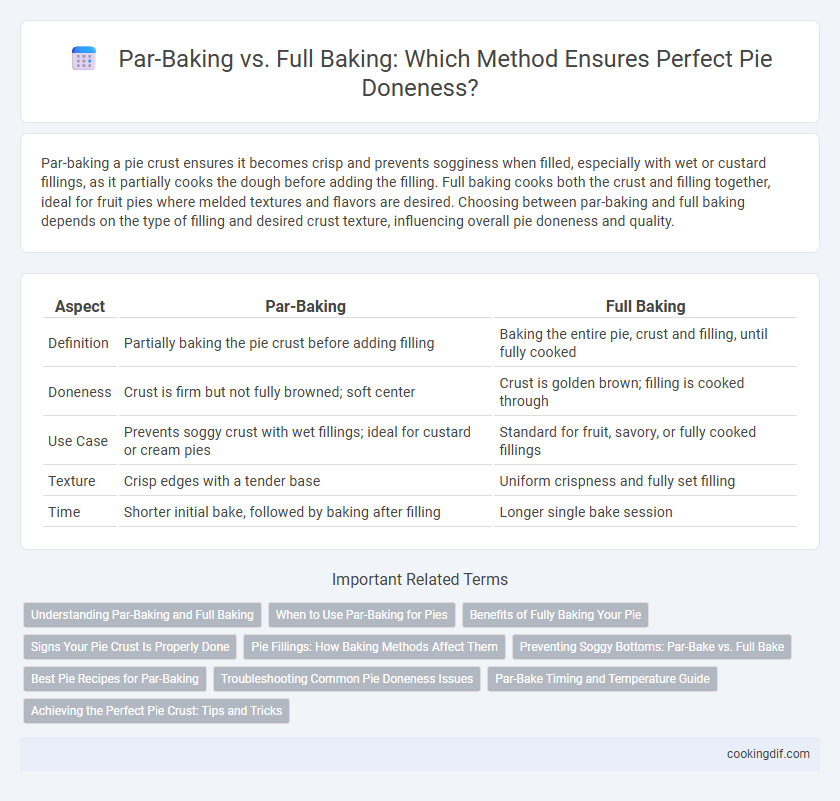Par-baking a pie crust ensures it becomes crisp and prevents sogginess when filled, especially with wet or custard fillings, as it partially cooks the dough before adding the filling. Full baking cooks both the crust and filling together, ideal for fruit pies where melded textures and flavors are desired. Choosing between par-baking and full baking depends on the type of filling and desired crust texture, influencing overall pie doneness and quality.
Table of Comparison
| Aspect | Par-Baking | Full Baking |
|---|---|---|
| Definition | Partially baking the pie crust before adding filling | Baking the entire pie, crust and filling, until fully cooked |
| Doneness | Crust is firm but not fully browned; soft center | Crust is golden brown; filling is cooked through |
| Use Case | Prevents soggy crust with wet fillings; ideal for custard or cream pies | Standard for fruit, savory, or fully cooked fillings |
| Texture | Crisp edges with a tender base | Uniform crispness and fully set filling |
| Time | Shorter initial bake, followed by baking after filling | Longer single bake session |
Understanding Par-Baking and Full Baking
Par-baking pie crust involves partially baking the crust before adding filling to ensure a crisp, fully cooked base that prevents sogginess. Full baking means baking the assembled pie with filling completely, allowing the crust and filling to cook together for a balanced texture and flavor. Understanding the differences helps in choosing the right technique for fruit pies, custard pies, or pies with wet fillings.
When to Use Par-Baking for Pies
Par-baking pies is essential when the filling requires little to no cooking, such as custard or fruit fillings that release excess moisture during baking. This technique helps maintain a crisp and firm crust by preventing sogginess caused by wet fillings. Use par-baking when a fully cooked crust is necessary before adding delicate or no-bake fillings to ensure optimal texture and pie doneness.
Benefits of Fully Baking Your Pie
Fully baking your pie ensures a crisp, golden crust and thoroughly cooked filling, enhancing both texture and flavor. This method reduces the risk of soggy bottoms and undercooked centers, delivering a consistent and satisfying eating experience. Fully baked pies also develop deeper caramelization and richer aromas, setting them apart from par-baked alternatives.
Signs Your Pie Crust Is Properly Done
A properly done pie crust exhibits a golden-brown color with uniform browning along the edges, signaling thorough baking. The crust should feel firm and crisp to the touch, not soft or doughy, ensuring the interior is fully cooked. Small cracks or flaky layers often indicate the perfect balance of moisture and heat, confirming that the pie crust is properly par-baked or fully baked for optimal texture and flavor.
Pie Fillings: How Baking Methods Affect Them
Par-baking pie crusts partially cooks the dough, preventing sogginess by creating a firm barrier that shields delicate fillings like custards or fruit from excess moisture. Full baking fully cooks both crust and filling simultaneously, allowing flavors to meld and filling to thicken properly, ideal for robust fillings such as pumpkin or pecan. Choosing the baking method impacts texture, moisture retention, and overall flavor balance in various pie types.
Preventing Soggy Bottoms: Par-Bake vs. Full Bake
Par-baking pie crusts creates a partially baked shell that helps prevent soggy bottoms by sealing the dough before adding wet fillings. Full baking involves baking the entire pie, but without par-baking, moisture from fillings can soak into the crust, leading to undesirable sogginess. Using par-bake techniques with blind baking weights or pie weights ensures a crisp, flaky crust ideal for custard or fruit pies with high moisture content.
Best Pie Recipes for Par-Baking
Par-baking pie crusts helps achieve a crisp, non-soggy base, essential for custard or fruit pies with wet fillings. Best pie recipes for par-baking, such as pumpkin or key lime pie, call for partially baking the crust before adding filling to ensure optimal texture and even doneness. Full baking suits pies with filling baked inside, but par-baking prevents sogginess and preserves structural integrity for perfect results.
Troubleshooting Common Pie Doneness Issues
Par-baking pie crusts prevents sogginess by partially cooking the dough before adding filling, ensuring a crisp base without overbaking the filling. Full baking involves cooking the crust and filling together, which can cause uneven doneness if the filling releases too much moisture or the crust edges brown too quickly. Troubleshooting common issues requires monitoring oven temperature, using pie weights during par-baking, and covering crust edges to avoid burning while achieving uniform pie doneness.
Par-Bake Timing and Temperature Guide
Par-baking pie crusts requires preheating the oven to 375degF (190degC) with the crust baked for 15-20 minutes, allowing it to set without fully browning. Adjust the time for deeper browning by extending up to 25 minutes when a crispier base is needed before adding wet fillings. Full baking temperatures typically range from 350degF to 425degF depending on the filling, while par-baking maintains structural integrity to prevent sogginess during the final bake.
Achieving the Perfect Pie Crust: Tips and Tricks
Par-baking pie crust involves partially baking the crust before adding the filling, which helps prevent sogginess and ensures a flaky, golden texture. Full baking, on the other hand, bakes the crust and filling simultaneously, ideal for fruit pies with juicy fillings that need to cook thoroughly. Using a pie shield or aluminum foil to protect the edges during baking enhances even browning and prevents burning, contributing to the perfect pie crust doneness.
Par-baking vs full baking for pie doneness Infographic

 cookingdif.com
cookingdif.com